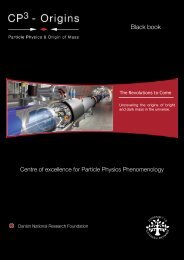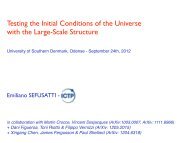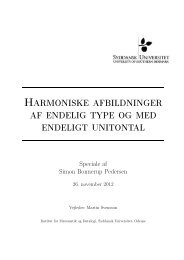PhD thesis - CP3-Origins
PhD thesis - CP3-Origins
PhD thesis - CP3-Origins
You also want an ePaper? Increase the reach of your titles
YUMPU automatically turns print PDFs into web optimized ePapers that Google loves.
Introduction to Elementary Particle Physics 15Now we can write the Higgs Lagrangian asL H = Tr (D µ Φ) † D µ Φ + µ 2 TrΦ † Φ − λ ( TrΦ † Φ ) 2, (2.42)where the covariant derivative isThe electroweak symmetry acts as followsD µ φ = ∂ µ Φ + i g 2 σ · W µΦ − i g′2 B µΦσ 3 . (2.43)SU(2) L :Φ → LΦ,U(1) Y : Φ → Φe − i 2 σ3θ .(2.44)We can make the global symmetry manifest by taking the hypercharge interactions tovanish, g ′ → 0. In this limit the Higgs Lagrangian has a global SU(2) R symmetrySU(2) R : Φ → ΦR † . (2.45)Therefore the Higgs Lagrangian has SU(2) L × SU(2) R symmetry which breaks down toSU(2) L+R when the Higgs field aquires a vev⎛ ⎞〈Φ〉 = √ 1 ⎝ v 0 ⎠ . (2.46)2 0 vThis breaking pattern yields three Goldstone bosons which are eaten by the Higgsmechanism providing masses to the weak gauge bosons.M 2 W = 1 4 g2 v 2M 2 Z = 1 4 (g2 + g ′2 )v 2 .(2.47)Thus, at tree levelρ =M 2 WM 2 Z cos2 θ W= 1, (2.48)where the θ W is the Weinberg angle. In the limit g ′ → 0 the W + , W − and Z bosonsform a triplet under the SU(2) L+R explaining why the masses are degenerate in this








